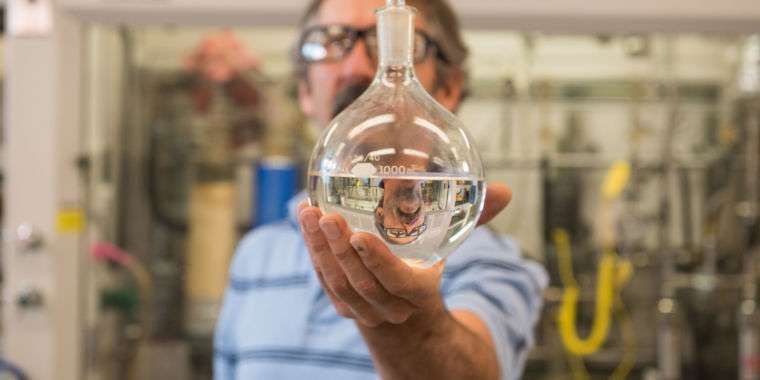
Tonight a Virgin Atlantic 747 will fly on fuel made from industrial waste gas

-
A researcher at Pacific Northwest National Laboratory holds a vial of fuel produced from industrial waste gas.
-
A Virgin 747 will burn a blend of fuel made from waste gas and jet fuel in a flight today.
-
The Chinese steel mill where LanzaTech opened its first waste-gas-to-ethanol facility this summer.
A little after 7pm ET tonight, a Virgin Atlantic 747 will take off from Orlando, Florida, bound for London’s Gatwick airport. This flight will be the first to use a blend of jet fuel and fuel made from industrial waste gas from a steel mill in China. This waste-gas fuel will displace some of the petroleum-based jet fuel that usually fills up a commercial jet’s tanks.
The company that makes the alternative fuel blend, LanzaTech, says third-party estimates show its fuels reduce greenhouse-gas emissions by more than 70 percent compared to burning the same amount of jet fuel.
The waste-gas fuel can be made from a variety of gases, LanzaTech says, but this jet fuel comes primarily from waste carbon monoxide that’s usually vented to the atmosphere from steel plants. Instead, LanzaTech captures the gases that come out of a steel plant and feeds them to a collection of proprietary microbes that eat the gases and create alcohol that can be refined into long hydrocarbons that create fuel.
LanzaTech’s partner in creating this process is the Pacific Northwest National Laboratory (PNNL), which said in a press release today that the resulting fuel “can be used for a range of low-carbon products, including alcohol-to-jet synthetic paraffinic kerosene (ATJ-SPK).” That specific type of jet fuel has recently been approved for use in commercial flights “at up to 50 percent blends with conventional jet fuel.” On this initial Virgin Atlantic flight, only five percent of the jet fuel will be replaced with industrial waste-gas fuel.
Still, the opportunity to replace up to 50 percent of a commercial jet’s fuel with recycled fuel is considerable, given blend ratios in the past. Qantas recently replaced 10 percent of its jet fuel with mustard-seed biofuel on one of its flights. In 2016, Alaska Airlines ran a test replacing 20 percent of its jet fuel with wood-waste alcohol. At the high end, United recently used a 30-percent biofuel blend for some of its flights between LAX and SFO.
The fuel
To create this fuel, LanzaTech harvested ethanol from its microbes in China and sent that ethanol to its facility in Georgia. That’s where it was refined into 4,000 gallons of ATJ-SPK fuel. The company plans to build a larger facility at the Georgia site to scale up the fuel-production process. PNNL notes that the Department of Energy’s Bioenergy Technologies Office has played a large role in getting this fuel process developed.
This process doesn’t have the same carbon-sequestration advantages that ethanol made from plants does; that is, plants consume carbon dioxide as they grow, taking some of that greenhouse gas out of the air. CO2 is released again as plant-based ethanol is created and then burned (although there is still a carbon advantage over fossil-based fuels).
In LanzaTech’s scenario, there’s no carbon-sequestration period at the beginning, but the process takes pollutant gases that are let into the atmosphere anyway and reprocesses them. The resulting fuel still releases CO2 as it’s burned but much less than would have been released if new oil had been drilled and refined into single-use jet fuel.
Freya Burton, a spokesperson from LanzaTech, said that the company’s microbes are capable of eating a mixture of carbon monoxide, hydrogen, and CO2. The fuel that LanzaTech produced for today’s Virgin flight primarily used carbon monoxide, a contributor to ozone pollution (though not a greenhouse gas), that would otherwise have been released into the atmosphere. The resulting fuel also releases fewer pollutants like nitrogen oxide, sulfur dioxide, and soot.
Burton said that LanzaTech is also working on using its waste-gas capture and processing methods to produce chemicals and consumer products that are otherwise produced with oil. In those use cases, LanzaTech would be “effectively locking the carbon in.”
For now, jet fuel is a good start. “This fuel exceeds the properties of petroleum-based jet fuel in terms of efficiency and burns much cleaner,” John Holladay, PNNL’s deputy manager for energy efficiency and renewable energy, said in a press release. “And by recycling carbon already in the environment—in this case waste gas streams—it lets the world keep more petroleum sequestered in the ground.”
One of the major selling points for LanzaTech’s technology is that it might eventually be able to compete with jet fuel on cost. The company estimates that 65 percent of the world’s steel mills could be retrofitted to collect the necessary waste gas to feed this process.
Thus far, airlines have been reluctant to make long- or even medium-term commitments to blending biofuel with jet fuel because biofuel creation is so cost-prohibitive. In a press release, Virgin Atlantic notes that this is not necessarily the case for LanzaTech, writing that “because [LanzaTech] uses a plentiful, affordable waste stream, this is set to keep the fuel price competitive with that of traditional jet.”
Virgin Atlantic stopped short of making any announcements of purchase contracts, but it did write that “airlines like Virgin Atlantic will be able to buy and fly it routinely, and that is when the big carbon savings will come.”
Listing image by PNNL




